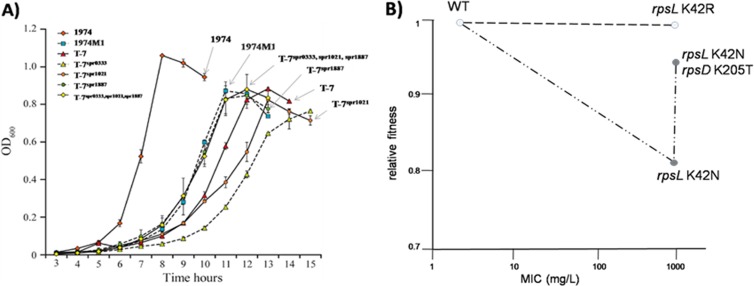Fig 5.
(A) Relationship between resistance, fitness, and compensatory mutations. The figure reflects the fitness (measured as growth capacity) of the S. pneumoniae wild-type (WT) strain (1974), the linezolid-resistant mutant (1974M1), the T-7 mutant (the 1974 WT strain with the main mutation involved in resistance, the 23S rRNA mutation G2576), which is less fit than strain 1974M1 (indicating the existence of compensatory mutations in the latter), the T-7spr1021 mutant (T-7 mutant with overexpression of the spr1021 gene, encoding an ABC transporter), which displays increased resistance to linezolid but with a clear biological cost, and finally the T-7spr0333,spr1021,spr1887 mutant (T-7 mutant with overexpression of the spr1021 and spr1887 genes and also the methyltransferase gene spr0333), which appears to restore the original fitness by the action of the new ABC transporter encoded by spr1887 (those commented on in the text are highlighted). (Reprinted from reference 171, which was published under an open-access license.) (B) High-level resistance to streptomycin in mutants of S. enterica subsp. enterica serovar Typhimurium. The fitness costs are reflected on the y axis. The K42R mutation in the protein encoded by rpsL gene is free of any fitness cost; however, the appearance of the K42N mutation in the same protein is associated with a biological cost, which can be almost totally compensated for by the secondary mutation K205T in RpsD protein. (Modified from reference 278 by permission from Macmillan Publishers Ltd.)

